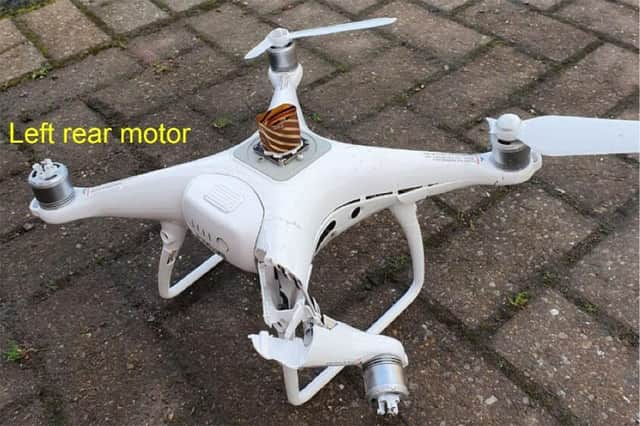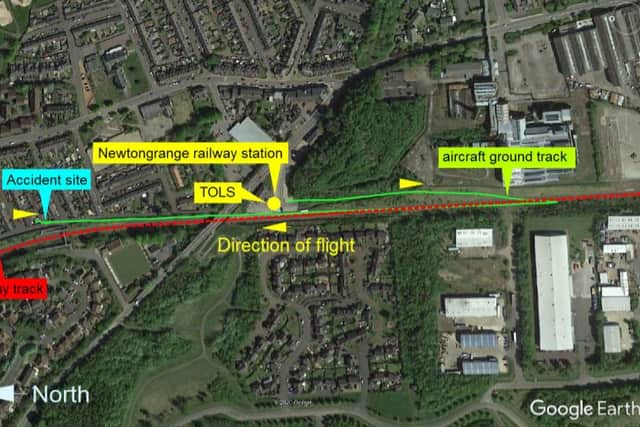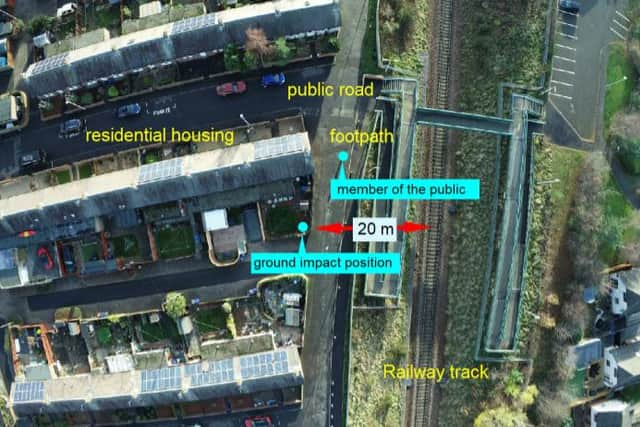Drone fell 230ft into back garden in Midlothian village when propeller detached while in flight
This article contains affiliate links. We may earn a small commission on items purchased through this article, but that does not affect our editorial judgement.


The DJI Phantom 4 RTK unmanned aircraft system rapidly descended and struck the ground near the house in Newtongrange, near Dalkeith, shortly after noon on December 2 last year.
No one was injured. However, an Air Accidents Investigation Branch (AAIB) report said a member of the public was 10 metres away from the crash site just before it spun out of control and fell to the ground.
Advertisement
Hide AdAdvertisement
Hide AdThe report concluded that the Civil Aviation Authority (CAA) “should consider prohibiting” drones which could injure people below.


Analysis indicated a blunt object with the same mass as the DJI Phantom 4 RTK (1.391kg) and falling from a height of just 25ft (8m) could result in a fatal injury to someone wearing a hard hat.
Data obtained from the accident flight log indicated that, from a height of about 196ft (60m), the drone’s descent rate “increased beyond that associated with free fall” due to the thrust from the propellers while it was inverted. The final speed of the drone before impact was estimated to be 36 metres per second.
The accident
The AAIB report said the drone was being operated in an automated flight mode to survey a railway track and surrounding infrastructure near Newtongrange railway station when one of its four propellers detached while in flight, causing it to rapidly fall to the ground from a height of 230ft (70m).


The drone was being used as part of a Network Rail survey of about 45 kilometres (28 miles) of railway track between Newcraighall and Tweedbank.
On the day of the accident, the drone successfully completed two flights prior and had flown for more than 30 minutes. The AAIB report said this indicates the propeller had probably been fitted correctly prior to the flight and that either the propeller or its locking mechanism to the motor may have failed.
But the drone manufacturer did not confirm if it had carried out a detailed inspection on the drone and so it was not possible for the AAIB to determine the cause of the in flight separation. The manufacturer did state it had “currently not seen any recurring pattern of similar cases.”
The AAIB previously made a safety recommendation to the CAA to specify the conditions that must be met for an unmanned aircraft to be flown safely over people, following an incident in Leeds in January 2020.
Advertisement
Hide AdAdvertisement
Hide AdIt also noted that while there has been a change in unmanned aircraft system (UAS) regulations, on December 31 2020, those holding permission for commercial operation (PfCO) or operational authorisation issued by the CAA “may overfly uninvolved people with a UAS of more than 250 grams and that is able to impart more than 80 Joules of kinetic energy”.
The AAIB report said: “It is recommended that, until an analysis of failure rates per flying hour has demonstrated an acceptable level of safety, the Civil Aviation Authority should consider prohibiting the overflight of uninvolved persons for those unmanned aircraft operating in the specific category which rely solely upon their propulsion system for lift that would, following a failure of the propulsion system, impact the ground with a kinetic energy exceeding 80 Joules.”
In January 2021, Network Rail stopped the use of DJI Phantom 4s in support of its survey activities and advised they intend to carry out trials using a drone with a mass of less than 250 grams for when there is a need for operations over uninvolved people.
The report said Network Rail had previously considered the use of parachute technology to limit the energy of a falling drone but concerns were raised about inadvertent operation and possible entanglement in the overhead line electrification system.
The drone was purchased new in October 2020 by the operator and had accumulated four hours of flight time.
A message from the Editor:
Thank you for reading this article. We're more reliant on your support than ever as the shift in consumer habits brought about by coronavirus impacts our advertisers.
If you haven't already, please consider supporting our trusted, fact-checked journalism by taking out a digital subscription at https://www.edinburghnews.scotsman.com/subscriptions.
Comments
Want to join the conversation? Please or to comment on this article.